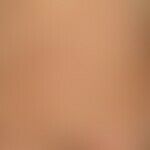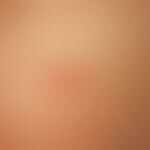Synonym(s)
HistoryThis section has been translated automatically.
Renucci 1835
DefinitionThis section has been translated automatically.
Common, worldwide spread parasitic skin infection caused by Sarcoptes scabiei var. hominis, accompanied by severe itching. The reactive dermatitis induced by the infection is to be interpreted as an immunological reaction of the organism to the mite components. The skin symptoms vary considerably depending on the duration of the disease, the individual reaction and the intensity of personal hygiene.
You might also be interested in
PathogenThis section has been translated automatically.
Acarus siro var. hominis or Sarcoptes scabiei var. hominis. S. u. Mites. Female scabies mites are 0.3-0.5 mm in size (males 0.21-0.29 mm) and are just visible to the naked eye as a black dot. Mating takes place on the surface of the skin. Male mites then die. Female mites dig tunnel-shaped passages in the stratum corneum and remain viable for about 30-60 days. The mite absorbs oxygen by diffusion via the skin surface (so-called astigmate mites; from the Greek α-/a-, "without" and stigma, here: "tracheal opening"). As a result, the mites only penetrate the stratum corneum, rarely deeper. They lay 2-3 eggs per day, from which the larvae hatch after 2-3 days. Scabies mites cannot survive outside the body for more than 48 hours. In immunocompetent patients, the number of mites found is low (10-12 per patient). In immunocompetent patients, the number can increase to > 1 million mites (clinical picture of Scabies crustosa, outdated also: S. norvegica).
Occurrence/EpidemiologyThis section has been translated automatically.
Common, 200-400 million cases/year worldwide. The prevalence is largely determined by socio-economic conditions, population density and hygienic conditions. It varies between < 1 % and 30-40 % and occurs epidemically. The prevalence is highest in subtropical and tropical regions, with children being affected disproportionately often. Scabies has been one of the WHO's neglected tropical diseases since 2017, but cases of scabies have also increased significantly in Europe in recent years. Exact figures on prevalence and incidence are not available due to the lack of mandatory reporting.
EtiopathogenesisThis section has been translated automatically.
Transmission of the mated female through close physical contact (sexual contact, sharing a (warm) sleeping place, living together in a confined space / between children), less frequently via laundry, textiles or fleeting contact (exception: Scabies norvegica). Brief contact such as shaking hands, hugging or touching the skin in medical settings is not considered to be a risk of infection. The risk of becoming infected through bed linen previously used by a scabies patient is < 1:200. There is a high risk of transmission with scabies crustosa, which mainly occurs in immunocompromised patients. In this highly contagious form, millions of mites are found in the affected skin or in the scales (Sunderkötter C et al. 2016).
PathophysiologyThis section has been translated automatically.
The number of mites increases to several hundred in the first three to four months after initial infection. Their number quickly drops again to around five to fifteen mites in immunocompetent individuals as part of an immune response mediated by T helper cells type 1/-2 and as a result of mechanical removal by scratching or washing (cf. the special features of Scabies crustosa). According to the classification of Coombs and Gell, post-scabies eczema is a type IV allergic reaction (late-type allergic reaction). The female itch mite lays 4-6 eggs a day in so-called mite ducts, which are located in the stratum corneum and can extend into the stratum granulosum. The characteristic itching and the typical eczema reaction are due to a cell-mediated immune reaction of the late type, which is directed against mite components and excrements. In the case of initial infestation, symptoms appear after two to five weeks, whereas in the case of reinfestation they are observed after just one to four days. Furthermore, IgE, IgM and IgG antibodies are formed, whereby the humoral immune response leaves no protective immunity against further infestations (Sunderkötter C et al. 2016).
Efflorescence(s)This section has been translated automatically.
LocalizationThis section has been translated automatically.
Mainly interdigital folds of the hands and feet, elbow bends, anterior axillary fold, areola, navel, girdle region, penis, ankle region, contact surfaces of the gluteae. The back is less frequently affected, head and neck as well as palmae and plantae are always free, (exception: in old people with atrophic palmae and plantae; in neglected patients the palms of the hands and soles of the feet may also be affected).
If scabies has been present for a long time (unkempt), the emphasis of the typical "scabies regions" is lost. A generalized eczema picture then appears (picture of microbial eczema).
In infants and small children: basically ubiquitous, also affecting palmae and plantae; backs of fingers and feet, face.
ClinicThis section has been translated automatically.
Scabies first becomes clinically symptomatic 3-6 weeks after infection. In the case of reinfection, clinical symptoms develop after just 24 hours. This leads to the mite being literally scratched out of the skin.
The main symptom of scabies is severe itching, particularly at night. In addition, there are winding, millimetre-long, clearly palpable mite ducts with the mite visible as a dark spot at the end of the duct (mite mound). Scratching effects, eczematization and secondary bacterial infections usually characterize the clinical picture.
The maculopapular, sometimes urticarial and papulovesicular skin changes are usually an expression of an allergic reaction of the organism to the mite infection (so-called Id reaction, scabid).
S. a.:
- Scabies eczematosa
- Scabies crustosa (norvegica)
- Scabies granulomatosa
- Scabies larvata
- Scabies (animal mange)
Other special forms:
- Cultivated scabies: Clinically only isolated papules; diagnostically important is the detection of mite ducts, which, however, must be sought. The strong nocturnal itching is indicative.
- Neglected scabies: Clinical picture of extensive "microbial eczema". It is necessary to look for duct structures, they are not in the foreground of the clinical picture. It is not uncommon for flat, verrucous plaques to form; also weeping or pustular areas.
- Scabies nodosa (persistent scabies granulomas): In young children and adults, even after sufficient antiscabial therapy, intensely itchy, 2-4 mm large, usually scratched papules may persist, probably as a hyperergic reaction to the persistent scabies allergen (late-type reaction).
- Post-scabies itching: Itching persisting for several days to possibly weeks after sufficient scabies treatment has been carried out.
- Scabies incognita: The clinical symptoms may be completely masked by systemically and topically applied glucocorticoids.
- Localized scabies: An example of localized scabies may be treatment-resistant nipple eczema.
- Scabies in infants and small children: Face, head, neck - also genital region (!) - and frequently (sometimes exclusively) palmae and plantae are affected. Efflorescences in children are often very succulent. Agonizing itching persists. Vesicles and pustules may occur. These may be clinically formative.
- Scabies in the elderly: Especially in patients with dementia, scabies often has an atypical clinical course, e.g. without the typical pruritus (in a larger study in 61% of cases / especially with existing diabetes mellitus), only recognizable by therapy-resistant eczematoid lesions (Cassell JA et al. 2018).
Detection method:
- Native detection of mites: opening of the mite duct using a fine cannula, application of the contents to a microscope slide, native examination under the microscope.
- It is also possible to visualize the mite duct by dabbing on a dye (felt-tip pen) and applying a drop of alcohol (dye is drawn into the duct by capillary forces).
- Microscopic detection of mites using reflected light microscopy (high sensitivity) (brownish triangular outline formed by the mite's abdomen).
- Histological detection of the mites (easily possible, especially in Scabies crustosa / norvegica; otherwise mite detection is only possible in step sections, if at all).
HistologyThis section has been translated automatically.
Acanthosis, also focal spongiosis, orthokeratosis, interspersed with parakeratosis mounds. Differently pronounced dermal edema; dense, diffuse and perivascularly oriented lymphohistiocytic infiltrate penetrating the upper and middle (often also deep) dermis. Frequently more or less pronounced histoeosinophilia. It is not uncommon to detect mite excrement in the form of round or oval globules (skybala) in the stratum corneum. In most cases, mites cannot be detected even in section series.
DiagnosisThis section has been translated automatically.
If symptoms typical of scabies are present (e.g. pruritus, suspicious skin florescences at the predilection sites), a suspected diagnosis can initially be made in conjunction with the epidemiological situation (infestation in the immediate vicinity). In accordance with the consensus criteria of the International Alliance for the Control of Scabies (IACS), a distinction is made between confirmed scabies, in which the mite or its products are directly visualized (level A), and clinical (level B) and suspected scabies (level C) in order to standardize the diagnosis.
A: confirmed scabies, at least one point applicable
- A1: Detection of mites, eggs or feces in skin samples by light microscopy
- A2: Detection of mites, eggs or feces by imaging device
- A3: Detection of mites by dermoscopy
B: clinical scabies, at least one point applicable
- B1: presence of mite ducts
- B2: typical lesions on the male genitalia
- B3: typical lesions with typical distribution pattern and two anamnestic criteria
C: suspected scabies, at least one point applicable
- C1: typical lesions with typical distribution pattern and one anamnestic criterion
- C2: atypical lesions with atypical distribution pattern and two anamnestic criteria
The diagnosis can be made at three levels (A, B or C). Clinical (B) or suspected scabies (C) should only be diagnosed if other differential diagnoses are considered less likely.
Differential diagnosisThis section has been translated automatically.
Histological: Allergic contact dermatitis; atopic eczema; other arthropod reactions.
Clinical: contact eczema; atopic eczema; microbial eczema; impetigo contagiosa; Paget's disease (in nipple eczema), dermatitis herpetiformis, diseases with erythroderma, pseudoscabies.
Complication(s)(associated diseasesThis section has been translated automatically.
General therapyThis section has been translated automatically.
In older children and adults, the entire body from the lower jaw downwards is treated with the antiscabiosum. In the case of scabies norvegica, the head should also be treated (leaving out the periocular and perioral region). After showering off or washing off the product, new underwear should be put on! Beds must be re-covered!
A recent control study on the application accuracy of e.g. 5% permethrin showed considerable deficiencies in the application by the patients (Nemecek R et al.2020). These application errors could be the cause of the lack of treatment success.
External therapyThis section has been translated automatically.
- Adults and adolescents:
- Permethrin 5 % in a cream base (e.g. InfectoScab®) is the treatment of first choice. Apply once for 8-12 hours, repeat after 14 days if necessary. In the case of severe infestation with inpatient treatment indication, we recommend a three-day local treatment.
- Alternative: Crotamiton (e.g. CROTAMITEX®) (see below).
- Alternatively: benzyl benzoate (see below); in case of itching of the capillitium, the hairy scalp can also be treated with 25% antiscabiosum, as this can be washed out of the hair as an emulsion.
- Alternative: Allethrin I (e.g. Jacutin®, Spregal® Spray (+ piperonyl butoxide)
- Alternative: 0.5% aqueous malathion lotion
- Alternative: 1% ivermectin lotion
Please note! In addition, change outer clothing and bed linen daily. Bed linen should be washed at > 60 °C. Alternatively: Store in a plastic bag for 3-5 days. The mites will then die.
- Alternative (rarely used): 5% tea tree oil.
- Alternative (rarely used): 10% precipitated sulphur in Vaseline or hydrophilic base(sulphur cream 2.5-10%): apply 2x/day for 3-7 days, each time after a soap bath.
- Pregnancy (see also pregnancy, prescriptions):
Note! None of the above-mentioned agents are licensed, so these treatment modalities can only be used off-label in pregnant women! Permethrin is listed in the Red List as a Group 4 drug, i.e. there is insufficient experience of its use in humans; animal studies have not shown any evidence of embryotoxic or teratogenic effects.
- Permethrin 5% in a cream base (e.g. InfectoScab) is the treatment of first choice. Apply once for 8-12 hours, repeat after 14 days if necessary.
- Benzyl benzoate (e.g. Antiscabiosum Mago 25%; alternative NRF formulation: benzyl benzoate emulsion 10 or 25%: apply once/day, use for 3 days, then rinse off.
- Alternative: 10% crotamiton ointment (e.g. Crotamitex® gel/lotion/ointment), apply for 3-5 consecutive days. Healing rates vary between 50-70%.
- Breastfeeding mothers: Therapy as for pregnant women.
- Primarily use permethrin and benzyl benzoate, see above (pyrethroids pass into breast milk; nothing is known about this with benzyl benzoate). According to the S1 guideline of the German Dermatological Society (as of 2016), a breastfeeding break of 5 days should be observed after treatment with permethrin and benzyl benzoate.
- Newborns and infants:
- Permethrin 2.5%(R194), leave on once for 8-12 hours. Treatment of the entire integument, including the head (excluding the mouth and eye area).
- Alternatively: Apply Crotamiton ointment for 3-5 consecutive days.
- Benzyl benzoate is not recommended; it is banned in the USA because of the so-called Gasping syndrome (severe progressive encephalopathy with metabolic acidosis and other symptoms). This syndrome occurred in infants whose catheters and infusion systems were flushed with benzyl alcohol.
- Infants or older children:
- Permethrin: Up to the age of 2 years 2.5%(R194), from the age of 2 years 5% (e.g. Infectoscab 5% cream, not on the capillitium as it cannot be washed out of hair), apply once over 8-12 hours.
- Alternatively: Benzyl benzoate 10% (e.g. Antiscabiosum Mago 10% for children, if necessary co-treatment of the capillitium possible, as emulsion can be washed out of the hair; or apply benzyl benzoate emulsion 10 or 25 % ( R027 ) once/day, apply for 3 days, then rinse off
.CAVE: Benzyl benzoate - see above.
- Alternatively: 2.5% precipitate sulphur in vaseline or hydrophilic base(R232): apply 2x/day for 3-7 days, each time after a soap bath (Caution: unpleasant odor).
- Immunosuppressed patients:
- Permethrin 5%, as recommended for adults. Repeat after 14 days.
- In case of recurrence, in addition to local therapy: oral application of ivermectin
- Severely eczematized patients:
- 2-3 days pre-treatment with a glucocorticoid externum (e.g. 1% hydrocortisone cream); then classic antiscabial therapy.
Internal therapyThis section has been translated automatically.
Systemic therapy with ivermectin (e.g. Driponin® or Scabioral®) is recommended in cases of resistance to therapy (more common in patients with HIV infection). Dosage: 200 µg/kg bw p.o. (max. up to 400 μg/kg bw) as a single dose, in cases of doubt always round up to whole 3 mg tablets. There is no maximum limit for the number of tablets to be taken. Take the calculated number of tablets at once (with water) and 2 hours apart with a meal (empty stomach). This is usually a single treatment. Treatment may need to be repeated after 2-4 weeks. A return to communal facilities can take place after 24 hours in accordance with the RKI recommendations (see source 1) if ivermectin is taken correctly.
NaturopathyThis section has been translated automatically.
Some small studies have been published on the alternative use of 5% tea tree oil, which prove the anti-scabies effect of this treatment. For further details, see tea tree oil below.
AftercareThis section has been translated automatically.
Pre- and post-treatment: Glucocorticoid-containing topicals such as 0.25% prednicarbate (e.g. Dermatop® cream) or methylprednisolone aceponate (Advantan® cream or lotion) are used for post-treatment and in the case of severely weeping, irritated skin prior to therapy. As dead mites continue to act as an allergen in the skin for weeks, itching often persists for some time after treatment. For open, weeping areas, apply moist compresses with antiseptic additives such as potassium permanganate, see also Eczema, post-scabies.
Note! Persistent itchy eczema in treated scabies is often caused by sensitization to killed mites, but occasionally by resistance to antiscabiosa or reinfection! Scabies granulomas should be treated with topical glucocorticoids (possibly under occlusion). In some cases, local injections with glucocorticoid crystal suspensions are necessary.
For contact persons: examination or co-treatment if disease is suspected.
Note(s)This section has been translated automatically.
If left untreated, scabies becomes chronic, but can also heal spontaneously after several years.
Resistance has been described for permethrin, crotamiton, lindane and benzoyl benzoate.
- A kdr mutation (knock-down resistance mutation) in the VSSC (voltage-sensitive sodium channel) in the neuronal membranes of S. scabiei var. hominis causes a reduced efficacy of topical permethrin.
- The described mutation is a non-synonymous A-to-T transversion: change of the amino acid from methionine to leucine at position 918 (M918L mutation)
- Permethrin binds preferentially to the open/active VSSC. The kdr mutation causes a shift of the channel to the closed state, resulting in poorer binding of the active substance and a reduced effect, but no resistance. There is still no in-vivo evidence of resistance to permethrin.
Note! Studies on the evidence and efficacy of topical antiscabiosa show the best results with permethrin.
School attendance is possible again after a single application of permethrin!
LiteratureThis section has been translated automatically.
- Agathos M (1994) Scabies. Dermatology 45: 889-903
- American Academy of Pediatrics (Scabies). In: Peter, G. (ed.) 2000 Red Book: Report of the Committee on Infectious Diseases, 25th ed. Elk Grove Village, IL pp. 506-508.
- Aristotle (340 BC) (1960) Animalium historia. In: Aristotelis opera, vol. I. De Gruyter Verlag
- Bezold G et al. (2001) Hidden scabies: diagnosis by polymerase chain reaction. Br J Dermatol 144: 614-618
- Cassell JA et al. (2018) Scabies outbreaks in ten care homes for elderly people: a prospective study of clinical features, epidemiology, and treatment outcomes.Lancet Infect Dis 18:894-902.
- Centers for Disease Control and Prevention. Parasites - Scabies. https://www.cdc.gov/parasites/scabies/index.html (2023). last accessed on 24.11.2024
- Chosidow O (2000) Scabies and pediculosis. Lancet 355: 819-826
- Chouela E et al (2002) Diagnosis and treatment of scabies: a practical guide. Am J Clin Dermatol 3: 9-18
- Dupuy A et al. (2006) Accuracy of standard dermoscopy for diagnosing scabies. J Am Acad Dermatol 56: 53-62
- Folster-Holst R et al. (2000) Treatment of scabies with special consideration of the approach in infancy, pregnancy and while nursing. Dermatologist 51: 7-13
- Haas N (1987) A simple vital microscopic aid for the detection of the scabies mite. Z Hautkr 62: 1395-1398
- Hu S et al. (2008) Treating scabies results. Arch Dermatol 144: 1638-1641
- Karre S et al (1997) Steroid-induced scabies norvegica. Dermatologist 48: 343-346
- Madan V et al. (2001) Oral ivermectin in scabies patients: a comparison with 1% topical lindane lotion. J Dermatol 28: 481-484
- Müllegger RR et al (2010) Skin infections in pregnancy. Dermatologist 61: 1034-1039
- Nemecek R et al. (2020) Application errors in local scabies therapy: an observational study. JDDG 18: 554-560
- Paasch U, Haustein UF (2001) Treatment of endemic scabies with allethrin, permethrin and ivermectin. Evaluation of a treatment strategy. Dermatologist 52: 31-37
- Sunderkötter C et al. (2016) S1 guideline on the diagnosis and treatment of scabies; AWMF registry no. 013-052)
- Tzenow et al. (1997) Oral treatment of scabies with ivermectin. Dermatologist 48: 2-4
- Walton S et al. (2004) Acaricidal activity of melaleuca aternifolia (tea tree) oil. Arch Dermatol 140: 563-566
Incoming links (58)
Acariasis; Acropustulosis of infancy; Allethrin i; Antiparasitosa; Arthropods; Asteatotic dermatitis; Benzyl benzoate; Benzyl benzoate emulsion 10 or 25 % (nrf 11.64.); Breast dermatitis; Caterpillar dermatitis; ... Show allOutgoing links (36)
Allergen; Allethrin i; Benzyl benzoate; Benzyl benzoate emulsion 10 or 25 % (nrf 11.64.); Breast dermatitis; Collagenosis reactive perforating; Crotamiton; Crusted Scabies; Diabetes mellitus; Eczematous scabies; ... Show allDisclaimer
Please ask your physician for a reliable diagnosis. This website is only meant as a reference.










































